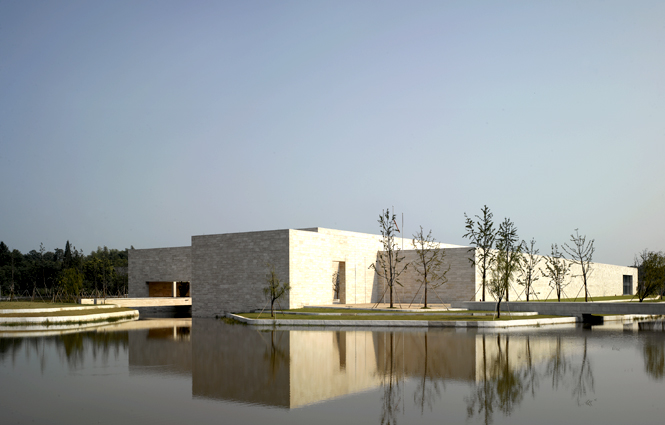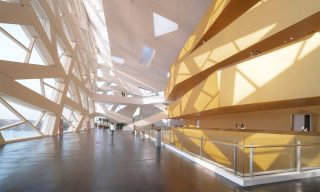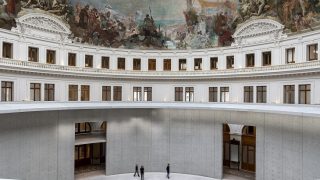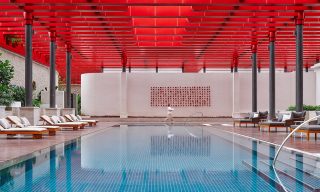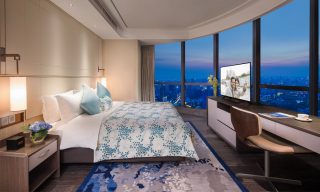Above: The Liangzhu Culture Museum on the outskirts of Hangzhou.
A new museum in Hangzhou provides a futuristic showcase for an ancient Chinese culture.
By Amy Fabris-Shi
China boasts many remarkable monuments to its several millennia of history. But, until recently, one of the Middle Kingdom’s earliest and most significant civilizations lay forgotten under industrial wasteland in suburban Hangzhou.
Seventy-five minutes by bullet train from Shanghai, the lakeside city of Hangzhou has long been one of China’s most prosperous communities, serving as the southern terminus of the Grand Canal as well as the imperial capital during the Southern Song dynasty (1127–1279). In 1935, during the construction of a public cemetery in the outlying suburb of Liangzhu, workers unearthed several ancient stone artifacts that suggested the area had also been an important center in prehistoric times.
Digs in the area over subsequent years revealed as many as 135 archaeological sites—treasure-filled tombs, multi-tiered altars, palace foundations, defensive ramparts, and the remains of villages and workshops—belonging to a previously unknown Neolithic culture dating back some 5,000 years, to the very origins of Chinese civilization.
Today known as the Liangzhu, these people lived in the fertile region of the Yangtze River Delta, establishing townships through present-day Zhejiang and Jiangsu provinces as well as Shanghai. The Liangzhu were consummate craftspeople, as evinced by the vast quantities of black-burnished pottery, lacquerware, and milky-white jade artifacts unearthed.
In a splendid example of China’s ability to reconcile its past with its future, hundreds of Liangzhu relics were recently given a sleek new home: a sprawling stone museum that juts out of the undulating terrain on the outskirts of Hangzhou like a stack of oversize shoe boxes. Opened last October, the Liangzhu Culture Museum comes courtesy of London-based architect David Chipperfield —his first project in China, extended to also include the design of a 100,000-square-meter residential district as part of the regeneration of the Liangzhu area into a smartly landscaped garden town.
Crouching over an artificial pond, the museum is a dramatic, but reverent, addition to the landscape. Composed of four staggered, rectangular volumes clad in creamy Iranian travertine stone, the solid structure gradually reveals itself through a linear series of bridges, courtyards, and galleries that are as intriguing for their elegant sculptural lines as they are for the ancient relics within.
“The museum is introverted to give focus and to protect the exhibition,” explains Mark Randel, director of David Chipperfield Architects. “When the visitor enters the first courtyard, they arrive in a secluded world. This borrows from traditional Chinese architecture.”
Visitors can pick up an English audio guide at the long ipe-wood reception desk and then proceed through the three main exhibition halls and temporary collections. The halls detail the discovery of Liangzhu sites and showcase the exquisite pottery and jade wares found—everything from solid columns weighing hundreds of kilograms to delicate huang: half-moon-shaped pendants thought to have been used as ritual objects during sacrifices or funerals. Although bordering on the tacky, the re-created Liangzhu village inside the museum is also worth visiting, if only for the thunder-effects that welcome you to the hall, which is otherwise detailed with thatched mud dwellings and life-size replicas of farmers and craftsmen.
When the thunder becomes too much, escape to the long, rectangular inner courtyards that link the exhibition spaces. Replete with reflection pools and carved wooden benches, bathed in a soft light reflected off the smooth, tan stone, these nooks are the ideal place to contemplate the museum’s extraordinary surrounds and the buried treasures beyond.
The Liangzhu Culture Museum (86-571/8877-8900) is a 45-minute drive from downtown Hangzhou; closed on Mondays.
Originally appeared in the February/March 2009 print issue of DestinAsian magazine (“Set in Stone”)

